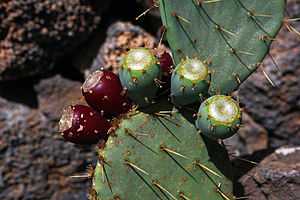Opuntia engelmannii
| Opuntia engelmannii | |
|---|---|
 | |
| Scientific classification | |
| Kingdom: | Plantae |
| (unranked): | Angiosperms |
| (unranked): | Eudicots |
| (unranked): | Core eudicots |
| Order: | Caryophyllales |
| Family: | Cactaceae |
| Genus: | Opuntia |
| Species: | O. engelmannii |
| Binomial name | |
| Opuntia engelmannii Salm-Dyck ex Engelmann | |
| Synonyms | |
|
Opuntia engelmanni (a common lapsus) | |


Opuntia engelmannii is a prickly pear common across the south-central and Southwestern United States and northern Mexico. It goes by a variety of common names, including "cow's tongue cactus", "cow tongue prickly pear", "desert prickly pear", "discus prickly pear", "Engelmann's prickly pear", and "Texas prickly pear" in the US, and "nopal", "abrojo", "joconostle", and "vela de coyote" in Mexico.[1]
The nomenclatural history of this species is somewhat complicated due to the varieties, as well as its habit of hybridizing with Opuntia phaeacantha.
Distribution
The Opuntia engelmannii range extends from California to Louisiana in the United States, and from Sonora (state) to the Tamaulipan matorral in Chihuahua (state), in Mexico.[1]
In the Sonoran Desert, terminal pads face predominantly east-west, so as to maximize the absorption of solar radiation during summer rains. Although found occasionally in the Mojave Desert, it tends to be replaced by Opuntia basilaris, which does not need the summer rain.
Description
The overall form of Opuntia engelmannii is generally shrubby, with dense clumps up to 3.5 metres (11 ft) high, usually with no apparent trunk. The pads are green (rarely blue-green), obovate to round, about 15–30 cm long and 12–20 cm wide.
The glochids are yellow initially, then brown with age. Spines are extremely variable, with anywhere from 1-8 per areole, and often absent from lower areoles; they are yellow to white, slightly flattened, and 1–6 cm long.
The flowers are yellow, occasionally reddish, 5–8 cm in diameter and about as long. Flowering is in April and May, with each bloom lasting only one day, opening at about 8AM and closing 8 hours later. Pollinators include solitary bees, such as the Antophoridae, and sap beetles.
The purple fleshy fruits are 3–7 cm long.
Varieties
- Opuntia engelmannii var. cuija — endemic to Mexico, in Guanajuato, Hidalgo, San Luis Potosí.[2]
- Opuntia engelmannii var. engelmannii — Engelmann's prickly-pear; Mexico, southwestern U.S., California [3][4]
- Opuntia engelmannii var. flavispina
- Opuntia engelmannii var. flexospina
- Opuntia engelmannii var. lindheimeri — Texas pricklypear; endemic to U.S. in Louisiana, New Mexico, Oklahoma, Texas.[5]
- Opuntia engelmannii var. linguiformis — cowtongue pricklypear; Texas (extinct—?) [6]
Uses
The fruits were a reliable summer food for Native American tribes.[7] The Tohono O'odham of the Sonoran Desert, in particular, classified the fruits by color, time of ripening, and how well they kept in storage.
Opuntia engelmannii is cultivated as an ornamental plant, for use in drought tolerant gardens, container plantings, and natural landscaping projects. Master Gardeners of the University of Arizona Pima County Cooperative Extension — Opuntia engelmannii
References
- Edward F. Anderson, The Cactus Family (Timber Press, 2001), pp. 497–498
- Raymond M. Turner, Janice E. Bowers, and Tony L. Burgess, Sonoran Desert Plants: an Ecological Atlas (Tucson: The University of Arizona Press, 1995) pp. 291–293
External links
| Wikimedia Commons has media related to Opuntia engelmannii. |
- USDA Plants Profile for Opuntia engelmannii (cactus apple)
- Opuntia engelmannii species account from ARS Germplasm Resources Information Network (GRIN)
- USDA Plants Profile for Opuntia engelmannii var. lindheimeri (Texas pricklypear)
- Opuntia engelmannii — U.C. Photo gallery